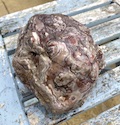
 |
| Latest Finds |
A new locality is mainly producing the most exquisitely beautiful specimens of uncracked vein agate. Vein agate like this is not common in Scotland as most of the well know areas produce nodular/amygdaloidal agates. As well as vein material we are also finding some beautiful nodular agates as well. |
 |
||||
 |
At another new locality near Dunure on the Ayrshire coast we have been finding some rather unusual “agates”. We think they are possible examples of agates called “Bacon agates”. This term has been created by an Italian scientist from Bologna University, Marco Campos-Venuti. Generally, bacon agates are agates in veins intimately associated with hydrothermal springs, but they are also occasionally found in nodular agates and thunder eggs. In bacon banding, the bands are poorly defined, discontinuous and with variable thickness. The geometry is shaky and non-linear with frequent wrinkles and often with a tendency to form colloform-like undulations. This is of course a theory that may help explain some of what we see in certain agates, but he admits that most agates are generated without biology. His theory is therefore that Bacon bands are the product of bacteria that precipitate chalcedony directly as a consequence of their metabolism. He also thinks that the whorled agates found on the Ross of Mull in Scotland may also show this Bacon banding. In his fascinating new book, “BIOMINERALS, Microbial Life in Agates and other Minerals” (http://www.agatesandjaspers.com/) he goes into more detail than I can cover here. I would therefore recommend this book to anybody interested in the theory of agate formation. At this new locality we have been finding some “strange” agates that would, even on close inspection, tend to support his theory. I will attach here a few photos of some of these specimens. |
 |
This is one of the specimens "as found" (approx 150 x 130mm rugby ball shaped) |
I have also put up here some photos taken of these agate slices in ultraviolet light (Long wave UV 365nm) as it is not uncommon for Bacon banding to fluoresce, certainly much more frequently than normal agates. This fluorescence occurs when activated elements are present inside the mineral which can be impurities of metal cations such as tungsten, molybdenum, lead, boron, titanium, manganese, uranium chromium, europium, terbium, dysprosium and yttrium. The same phenomenon is seen in organic matter. So, the fluorescence of the Bacon bands could be a secondary effect of their association with bacterial biofilms. Of course the final proof of this theory would be finding, somewhere on Earth, where agates were in this formation phase and it would be possible to isolate the causative bacteria forming chalcedony in an amygdale or vein…..so far this has not been discovered, probably because nobody has looked in the right places! |
At another locality this “big boy” was discovered in a field not far from Ayr. Too big to get in my bag it has been safely rolled out of the field to be collected later. The landowner is delighted with this find. It will be cut at some point and hopefully what is revealed will be interesting…on the broken surface it show agate and Amethyst. (hammer head 165mm) |
 |
"Big Boy"......More information later....watch this space.... |
As well as the “Big Boy” we have also found some other exceptional agates in the same area of the field. There are also a fair number of Quartz nodules with a lot of them trending towards Amethyst. |
First agate from a new locality in Kintyre. Interesting, mainly pale purple/pink agates in matrix but with the possibility of many more to come. |
Yet another new agate locality in South Ayrshire as the hundreds of miles of new tracks are put in. This is a small quarry that we are only now beginning to assess but it is looking very promising. There appears to be a mixture of nodular agates with some rather interesting vein material as well….more to come I’m sure. |
Here are a few wee agates found over the last winter months of 2024 and this Spring 2025 from around Dunure, here in South Ayrshire, Scotland. |
This specimen is definitely an agate but certainly not from any of the well know agate producing areas in Scotland. It was found on the beach at John o’ Groats on the very northern tip of Scotland 3-4 years ago by Trijntje Blaauwwiekel. It just shows what you can find if you look! |
I have been hearing about another, probably temporary, source of some nice vein agate from in the Cheviot Hills, South of Scotland. They are mainly red and white vein agates with some beautiful intricate details. I will add more of them as I find them….. |
We have recently been finding some beautiful agate nodules at a new locality near Dunure here in Ayrshire. They are mainly onyx agates, but not all! I have found agates in this general area before and for some reason they were also mainly onyx agates. |
 |
I have been given these rather unusual specimens that I will call “Jaspers” by John Trudgill from Stonehaven. They are all rather unusual and unique and all from the Stonehaven area. |
| < Home |